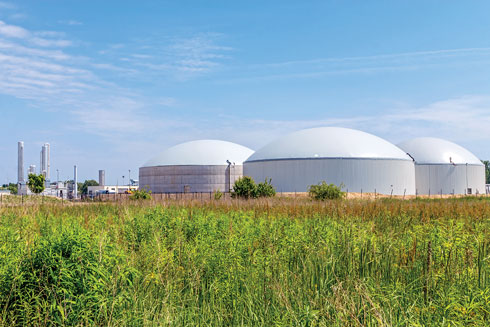Gas and the energy transition—repurposing the system with hydrogen
DNV GL’s “2018 energy transition outlook,” an independent forecast of the world energy mix in the lead-up to 2050, predicts that global upstream gas capital expenditure (CAPEX) will grow from $960 B in 2015 to a peak of $1.13 T in 2025. Upstream gas operating expenditure (OPEX) is set to rise from $448 B in 2015 to $582 B in 2035, when operational spending will be at its highest.
Natural gas projects will receive a significant investment boost over the coming years. This will enable gas to overtake oil as the world’s primary energy source in 2026 and account for one-quarter of the world’s energy by mid-century.
While DNV GL’s model predicts that global oil demand will peak in 2023, demand for gas will continue to rise until 2034. New oil and gas resources will be required long after these dates, however, to continue replacing depleting reserves.
DNV GL believes that gas will fuel the energy transition in the lead-up to the mid-century, as it sets a pathway for the increasing uptake of renewable energy, while safeguarding the secure supply of affordable energy that the world will need during the energy transition.
Value chain transitions. Rising global demand for gas will impact activity across the oil and gas value chain, according to DNV GL’s outlook. Conventional onshore and offshore gas production is forecast to decline from around 2030, while unconventional onshore gas is expected to peak in 2040. DNV GL expects this trend to lead to leaner, more agile gas developments with shorter lifespans.
Northeast Eurasia (including Russia), and the Middle East and North Africa will account for most onshore conventional gas production in the lead-up to 2050, while North America will continue to dominate unconventional gas production. What is considered unconventional today will be seen as conventional tomorrow. In the offshore sector, the Middle East and North Africa will see the highest yearly rate of new gas production capacity from now until at least 2050.
LNG capacity will increase as production rises. DNV GL expects it to double by the late 2040s, as the midstream sector connects shifting sources of gas with changing demand centers. Seaborne gas trade from North America to China is forecast to triple by 2050. An increase in trade from sub-Saharan Africa to the Indian subcontinent and Southeast Asia is also anticipated.
DNV GL’s forecast points to a faster, leaner and cleaner oil and gas industry in the future. The sector must increase its focus on developing digital technologies that will enable quicker and more agile exploration and production, and the smooth integration of less-carbon-intensive gases into the energy system.
Decarbonization of the gas industry. Although natural gas has a lower carbon impact than other fossil fuels, it still contributes significantly to carbon emissions. If the world is to meet the aims of the Paris Agreement, a switch must happen to decarbonize the gas chain or convert to carbon-neutral sources of gas.
The main sources of carbon-neutral gas sources are hydrogen (H2), biomethane produced from anaerobic digestion (AD), and biosynthetic natural gas (SNG) generated from the gasification of renewable carbon feedstocks. A further option is methane produced by methanation of H2 generated using renewable electricity sources (RES) and captured carbon dioxide (CO2).
Biomethane. Biogas is widely used for power generation (Fig. 1). In countries with well-developed natural gas infrastructure, an increasing number of plants are further treating the biogas to produce biomethane suitable for injection into the gas grid. One such region, Europe, is the main global location for biomethane production.
 |
|
FIG. 1. Storage tanks for biogas, widely used for power generation. |
The industry in Europe benefits from public policy support, including national feed-in tariffs and carbon pricing, and a new European cross-border trading mechanism, the European Renewable Gas Registry. In December 2016, the region had 503 biomethane plants operating, according to the European Biogas Association (EBA). Biomethane is also seen as a solution for the ‘circular economy’ for smaller, off-gas-grid locations, where local housing or businesses can be supplied by gas from a local biomethane plant.
The EBA estimates that total biomethane production in Europe in 2016 was nearly 17.3 gigawatt hours (GWh), 40% greater than in 2015, marking 5 yr of uninterrupted annual growth from 0.8 GWh in 2011. For perspective, EU gross inland consumption of natural gas in 2016 was nearly 5,000 GWh, according to Eurostat; biomethane was equivalent to barely more than 0.3% of this consumption. Germany has the greatest number of biomethane plants in the region, although growth in numbers has stagnated in the country due to policy shifts. The EBA highlights France as having potential for significant growth of biomethane production within 2 yr–5 yr.
While biogas produced locally from readily available waste (e.g., sewage, manure and forest residues) is generally seen as environmentally beneficial and sustainable, biogas can be more controversial where arable land is taken up with large-scale production of energy crops, or where feedstock must be transported over a long distance to reach a production facility. Another potential limit to biogas growth is the prioritization of biomass for conversion to fuels for sectors with few or no low-carbon options, such as aviation and long-distance shipping.
Bio-SNG. Carbon-rich feedstocks, such as coal and oil, can be gasified to produce syngas—a blend of carbon monoxide (CO), H2 and other gases. Syngas can be used as feedstock for many large-scale chemical processes. Another option for syngas is its conversion, via proven processing steps, to methane. Use of syngas-derived methane as a substitute for natural gas is already practiced at several sites in the US and China.
Syngas produced from the gasification of biomass can similarly be converted to bio-SNG. This artificially created, methane-based gas, known as renewable natural gas (RNG) in North America, is considered carbon-neutral. Although biomass gasification of woody residues and wastes is common worldwide, bio-SNG production is practiced at demonstration scale at several plants in Europe. In the longer term, bio-SNG production could outstrip biomethane as a source of carbon-neutral methane, but its use will be constrained by the availability of suitable feedstocks and competition for these feedstocks from other sectors.
Hydrogen. For countries with a well-developed gas infrastructure, a step-change solution beyond that offered by biomethane and bio-SNG is needed to meet the 2050 carbon emissions targets. In the UK, electrification of heating has been proposed as an alternative to natural gas use, but closer study has shown that the lowest-cost routes to decarbonizing the highly seasonal demand for gas heating involve retention of most of the gas network.
H2, coupled with carbon capture and storage (CCS), is part of this solution. Provided that any CO2 arising from H2 production is captured and sequestered, the use of H2 in a gas grid reduces or eliminates CO2 emissions from all gas users connected to that grid. In this way, many small, geographically scattered CO2 sources are replaced by a single large source, dramatically reducing capture and transport costs.
A gas grid built or repurposed to supply H2 has two other significant benefits:
- Much of the existing gas distribution infrastructure in the UK, for example, can be repurposed for H2 or to support the distribution of H2, including more than 230,000 km of low-pressure local distribution networks.
- H2 generated by electrolysis using electricity from wind, solar or other low-carbon sources during periods of low electrical demand can be accepted into the gas grid. This links the electricity and gas grids, increasing the flexibility of the entire system, as the fraction of variable renewable energy sources increases. Energy storage of H2 or natural gas in underground cavities or depleted gas fields not only help meet daily demand variations but can also meet seasonal variations in power or heat demand.
Several options are under consideration for H2 introduction to gas grids:
- Conversion to 100% H2—Projects such as H21 North of England propose the replacement of natural gas with H2 in entire regions of the gas grid. This approach retains all regional gas infrastructure but requires the development of a robust H2 delivery chain and the replacement of all user appliances connected to the grid with equipment suitable for 100% H2.
- Use of natural gas H2 blends—Most appliances in use can safely operate with H2 concentrations up to 10%–20% in the grid. Blending H2 into the grid in this way offers a lower-cost shortcut to a limited reduction in CO2 emissions. UK projects such as Hynet are exploring this option.
In practice, both approaches may be adopted in different regions or countries.
Challenges of hydrogen. The UK gas industry can draw on more than 50 yr of experience with natural gas. During this time, the gas grid has undergone a continuous process of maintenance, upgrading, strengthening and replacement. Switching to H2, either totally or as a blend with natural gas, will mean that the practices, materials and technologies developed over this long period must be reviewed and, if necessary, revised or replaced.
Safety. H2 has significantly different physical and chemical properties to conventional natural gas mixtures. These differences combine in various ways to affect the way H2 behaves and the hazards it presents. The balance of how these conflicting factors affect the risk is complex. For example, H2 leakage rates from pipework, fittings and equipment may be higher than those of natural gas, but because H2 has a much lower density than natural gas, an H2 leak may disperse more rapidly than escaped natural gas.
This means that the risks associated with replacing natural gas with H2 cannot be assessed by a direct comparison of properties; instead, a detailed understanding of the nature and magnitude of H2 leaks and the behavior of H2 must be used to assess whether and how H2 accumulations might occur and the severity of any resulting explosion or fire.
To address the concerns related to H2 safety in housing, DNV GL is building a street of houses at its Spadeadam Research facility in the UK, which will be heated by H2. This HyStreet will allow H2 dispersion testing to be completed in a representative set of houses that will also be available for equipment suppliers, such as boiler and cooker manufacturers, to test their equipment in a real-world environment. Spadeadam is also being used to test a range of gas network distribution equipment to determine their suitability for H2 applications.
Materials. H2 is not especially corrosive, but several mechanisms involving H2 can cause embrittlement or damage to engineering alloys. Much of the local gas distribution network in the UK has been laid or replaced in recent years with polyethylene piping, which is resistant to H2 attack. This replacement program is expected to continue until 2030.
This is a potential concern if existing metallic pipelines and equipment are used for the transmission of H2 gas or H2-gas mixtures, and it is likely that long-distance bulk H2 transport will require a new H2 transmission system. To date, commercial H2 pipelines have been designed using lower-strength carbon steels that are resistant to embrittlement. Similarly, resistance and permeability tests are needed for polymers used for gaskets and seals in valves, fittings, joints and other pipeline equipment.
Pipelines and gas installations. The lower density and lower calorific value of H2 compared to natural gas means that gas velocities in pipelines and gas installations will be up to three times higher. A program of test work will be needed to ensure that the many control and pressure reduction installations in the network are suitable for H2 use and, if not, to determine the modifications needed.
Operations and maintenance. Introduction of H2 will require new gas detection methods and instruments, since existing detection equipment is designed for conventional natural gas mixtures that do not include H2. Similarly, equipment for routine monitoring and flow measurements will need to be replaced or recalibrated to take into account the different properties (chemical and physical) of H2 or H2-rich gas blends. DNV GL is providing governance on the designs of the next generation of gas detection equipment for the identification of a wide range of pipeline and non-pipeline gas products, including CO and the distributed gas odorant, mercaptan.
A concern has been gas odorization. DNV GL has recently assessed potential odor masking by H2 addition (up to 20%) in natural gas. Higher concentrations of H2 will require further study or assessment of alternative odorants via practical testing in purpose-built facilities.
Equipment used during maintenance must be suitable for atmospheres where H2 is present. The procedures for isolating, venting, purging and then recommissioning sections of the grid will need to be carefully assessed to take account of the different flow properties of H2 and the differences between its ignition properties and those of natural gas.
Emergency procedures may need to change where H2 is present to take account of differences in transport, combustion and ignition properties and the behavior of H2 as a gas.
Hydrogen use for industrial feedstock will keep growing. H2 demand for industrial feedstock is anticipated to rise from approximately 55 MMtpy at present to 69 MMtpy–114 MMtpy in 2050. The iron and steel industry may begin to use H2 in the direct iron reduction steelmaking process. This may add 4 MMtpy–11 MMtpy of H2 consumption by 2050.
Decarbonization of industry. Emerging and enabling greener gas technologies will play a part in the transition as the industry looks to decarbonize. Carbon capture, utilization and storage (CCUS) is a key technology for climate change mitigation. It reduces emissions from large point-sources in energy production from fossil fuels, and from other sectors with high CO2 emissions from production. These sources include ammonia, cement, iron and steel manufacturing.
The International Energy Agency (IEA) and the Intergovernmental Panel on Climate Control (IPCC) have both indicated that CCUS is a critical component of keeping the rise in average global temperature below 2°C compared with pre-industrial levels.
Takeaway. The gas industry is looking to transition from conventional fossil-sourced fuels. The introduction of H2 into the energy mix is a potential solution and could form an important part of a low-carbon future; however, extensive work will be needed to prove that the introduction of H2 will not compromise the safety and integrity of gas networks and that there is no increase in risk to the public, either directly or indirectly.
A further major barrier will be implementing and funding conversion to H2. In addition to H2 production facilities, carbon capture and storage facilities, and new H2 transmission and storage systems, there is the cost of replacing consumer gas appliances. Although studies suggest that retention of existing gas infrastructure by conversion to H2 offers the lowest-cost option for heat decarbonization, reduction of these costs through knowledge, technology and innovation will be vital to enabling this transition. GP
 |
Graham Bennett is Vice President of Business Development for DNV GL’s UK and West Africa regions, and has worked with DNV GL for the last 24 yr. He holds a first-class honors degree in mechanical engineering. He has written and provided training courses in risk and reliability assessment, and he is the primary author of many papers, including DNV GL’s recently released “Energy transition outlook.” Mr. Bennett has led several incident investigations in the major hazard industries, and subsequently assisted the companies concerned with recovery programs. He has also supported several clients in both the industrial and financial segments in purchaser and vendor due diligence reviews for mergers, acquisitions and disposals.
 |
Andrew Williams is Senior Principal Consultant at DNV GL – Oil & Gas in Loughborough, UK. He completed his PhD in chemical engineering before starting work in the UK gas industry in 1989. After 3 yr working on gasification and syngas processing, he then spent 12 yr working on oil and gas projects, undertaking flow assurance and gas processing studies for major oil and gas clients. In 2005, Dr. Williams returned to gasification, and for the next 10 yr served as lead process engineer during the delivery of three gasification process packages for commercial gasification plants in China. Since 2015, he has applied his background in gas manufacturing and processing to the new challenges posed by the decarbonization of the gas industry, and has undertaken techno-economic studies on bio-SNG deployment and gasification for H2 production.




Comments